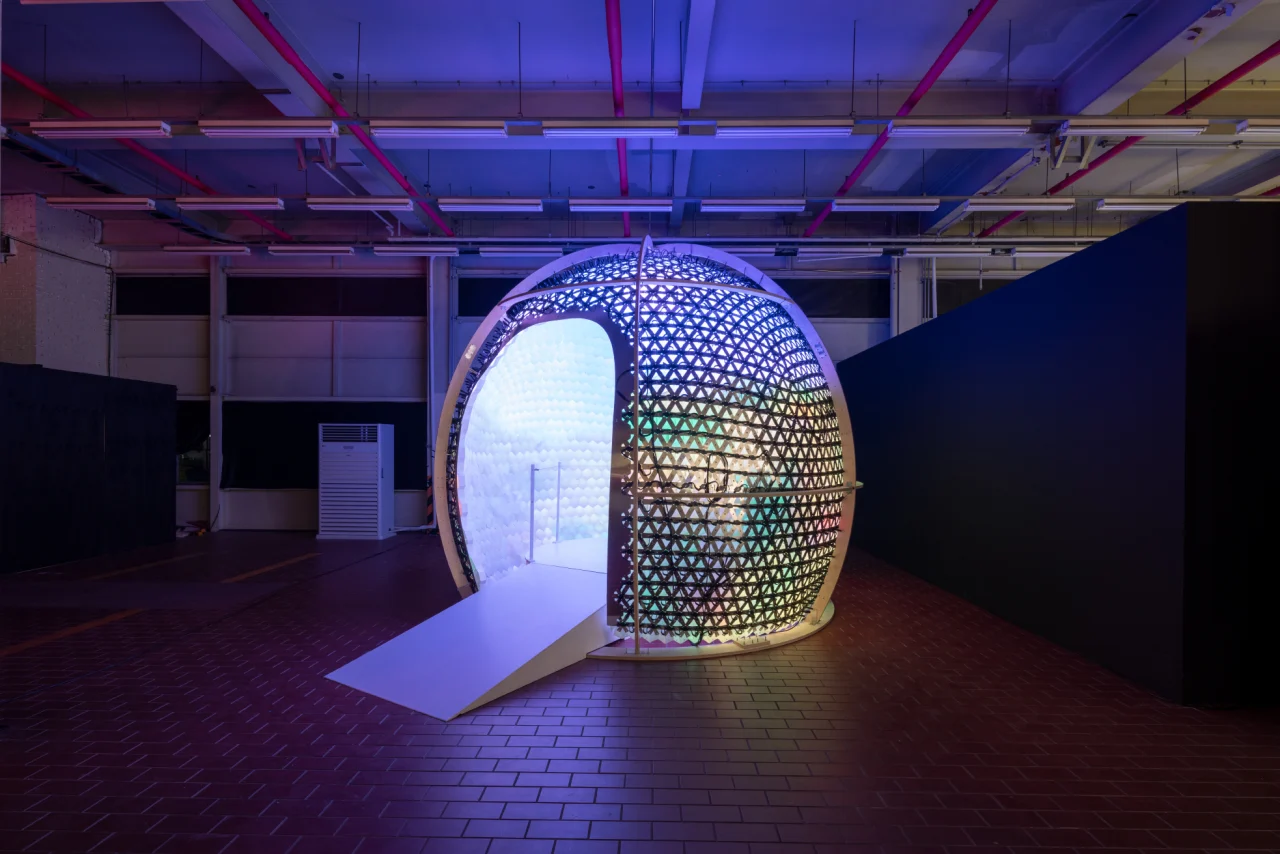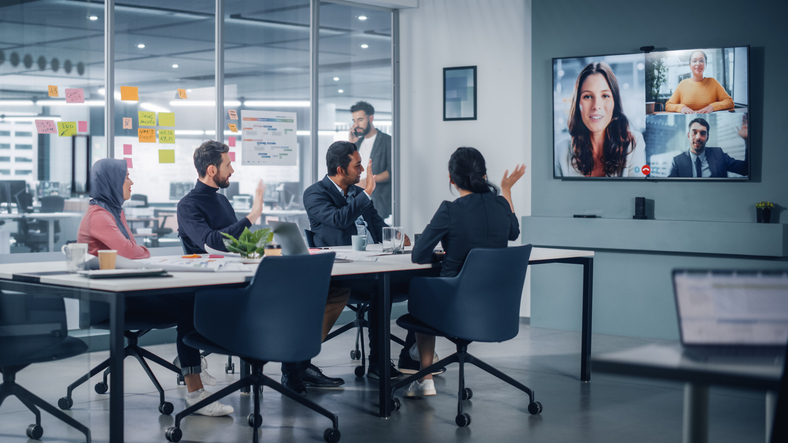Why Hyundai is looking outside its own walls to build a bold new future
Every October, an exhibition in Seoul celebrates the artistic endeavors of ZER01NE, Hyundai Motor Group’s creative talent–nurturing platform. Last year, the theme was 01 HABITAT, which explored the coexistence of human and nonhumans—robots, micro-creatures, animals, and plants—in the design of smart cities and the future of mobility. One of the more compelling presentations came from a British artist: a sphere mimicking the compound eye of a dragonfly, one that attendees could go inside to experience the world as the dragonfly sees it. Experiencing an insect’s worldview may seem unrelated to a mobility company’s core business, but it’s just one example of how Hyundai seeks to improve the well-being and quality of life for humanity through technology or services. To that end, ZER01NE nurtures not only entrepreneurs, but also media artists, computer programmers, and engineers, through a combination of investment, immersive experience education, and collaborative proof of concept (POC) programs. Between 2017 and 2023, Hyundai invested in more than 200 global startups focusing on mobility services, electrification, and connectivity. ZER01NE is Hyundai’s domestic proving ground for Open Innovation, a forward-looking program that actively encourages the cross-pollination of external ideas, technologies, and expertise to advance business objectives along with social goals. Yun Seong Hwang, Hyundai Motor Company advisor, explains that artistic goals are supported “unconditionally, so that people can manifest the beautiful things in their mind.” Over time, these creators can then apply creative instincts to what Hwang calls “more purposeful endeavors,” such as robotics, mobility, or inclusivity in mobility. Take, for instance, the experiments and prototypes of a sustainable EV charging shelter presented by a Singapore-based team; built from kenaf and clay, it employs a traditional design that cools outside air without using electricity. “The imagination of our engineers and planners can be limited,” Dr. Hwang says, “but outside creators can provide a wider view.” INNOVATION FROM THE OUTSIDE Hyundai’s Open Innovation initiatives predate the coining of the term itself in 2003, stretching back to the Y2K wave of innovation surrounding the dot-com explosion. That was when Hyundai recognized that in-house startups—along with strategic outside investment—can, as Hwang puts it, “secure innovation from the outside,” spurring profound mutual progress instead of simply outsourcing parts or functions. “Our goal is to create a win-win system by actively investing in and fostering startups that create new customer value and give us important insights in the course of cooperation,” Hwang says. “That way we can make new things, new value, that doesn’t [yet] exist. That is the meaning of Open Innovation.” It was a radical departure from the traditional auto-making pyramid model, in which R&D was siloed and kept secret. But as basic car demands (endurance, structure, safety) gave way to mobility concerns—electrification, autonomous driving, ride sharing, and mobile phone connectivity—Hwang says, “the rules of the game changed.” Noting the location of the firms propelling the change (Google, Tesla, Uber, Apple), Hyundai expanded its Open Innovation operations to Silicon Valley in 2011. “This was the big realization: The elements changing the industry were coming from entrepreneurs and startups. The real game became who would master this new skill first?” HEALTHY INTERNAL COMPETITION In 2017, with mobility accelerating, Hyundai expanded its Open Innovation initiatives substantially, launching ZER01NE, while opening or rebranding five global offices in innovative epicenters—Tel Aviv, Beijing, Berlin, Singapore, Silicon Valley—under the name CRADLE (as in cradling new innovation). Each CRADLE epicenter offers its own unique capability, ranging from creativity to engineering expertise. “Hyundai is doing global business, so we need to get the best talent on a global level,” says Keith Noh, head of OI Strategy Group. “This is the most important part of Open Innovation.” ZER01NE and CRADLE evaluate a wide range of cutting-edge technologies through POC projects with startups and R&D, ultimately investing in the most promising startups across the local regions. ZER01NE gathers technical needs from various R&D teams and business units within Hyundai headquarters in Seoul, after which CRADLE recruits and recommends the most talented startup teams to meet those needs. Each year, more than 50 POC projects are executed, involving more than 150 internal teams. This entire open innovation process results in what Noh describes as “healthy competition in the workplace” Hyundai’s strategic investment and entrepreneurial nurturing has had tremendous success. The company was an early investor in SoundHound, applying the startup’s music recognition algorithm to revolutionize voice-recognition technology. Hyundai’s work gro

Every October, an exhibition in Seoul celebrates the artistic endeavors of ZER01NE, Hyundai Motor Group’s creative talent–nurturing platform. Last year, the theme was 01 HABITAT, which explored the coexistence of human and nonhumans—robots, micro-creatures, animals, and plants—in the design of smart cities and the future of mobility. One of the more compelling presentations came from a British artist: a sphere mimicking the compound eye of a dragonfly, one that attendees could go inside to experience the world as the dragonfly sees it.
Experiencing an insect’s worldview may seem unrelated to a mobility company’s core business, but it’s just one example of how Hyundai seeks to improve the well-being and quality of life for humanity through technology or services. To that end, ZER01NE nurtures not only entrepreneurs, but also media artists, computer programmers, and engineers, through a combination of investment, immersive experience education, and collaborative proof of concept (POC) programs. Between 2017 and 2023, Hyundai invested in more than 200 global startups focusing on mobility services, electrification, and connectivity.
ZER01NE is Hyundai’s domestic proving ground for Open Innovation, a forward-looking program that actively encourages the cross-pollination of external ideas, technologies, and expertise to advance business objectives along with social goals. Yun Seong Hwang, Hyundai Motor Company advisor, explains that artistic goals are supported “unconditionally, so that people can manifest the beautiful things in their mind.”
Over time, these creators can then apply creative instincts to what Hwang calls “more purposeful endeavors,” such as robotics, mobility, or inclusivity in mobility. Take, for instance, the experiments and prototypes of a sustainable EV charging shelter presented by a Singapore-based team; built from kenaf and clay, it employs a traditional design that cools outside air without using electricity. “The imagination of our engineers and planners can be limited,” Dr. Hwang says, “but outside creators can provide a wider view.”
INNOVATION FROM THE OUTSIDE
Hyundai’s Open Innovation initiatives predate the coining of the term itself in 2003, stretching back to the Y2K wave of innovation surrounding the dot-com explosion. That was when Hyundai recognized that in-house startups—along with strategic outside investment—can, as Hwang puts it, “secure innovation from the outside,” spurring profound mutual progress instead of simply outsourcing parts or functions.
“Our goal is to create a win-win system by actively investing in and fostering startups that create new customer value and give us important insights in the course of cooperation,” Hwang says. “That way we can make new things, new value, that doesn’t [yet] exist. That is the meaning of Open Innovation.”
It was a radical departure from the traditional auto-making pyramid model, in which R&D was siloed and kept secret. But as basic car demands (endurance, structure, safety) gave way to mobility concerns—electrification, autonomous driving, ride sharing, and mobile phone connectivity—Hwang says, “the rules of the game changed.” Noting the location of the firms propelling the change (Google, Tesla, Uber, Apple), Hyundai expanded its Open Innovation operations to Silicon Valley in 2011. “This was the big realization: The elements changing the industry were coming from entrepreneurs and startups. The real game became who would master this new skill first?”
HEALTHY INTERNAL COMPETITION
In 2017, with mobility accelerating, Hyundai expanded its Open Innovation initiatives substantially, launching ZER01NE, while opening or rebranding five global offices in innovative epicenters—Tel Aviv, Beijing, Berlin, Singapore, Silicon Valley—under the name CRADLE (as in cradling new innovation). Each CRADLE epicenter offers its own unique capability, ranging from creativity to engineering expertise. “Hyundai is doing global business, so we need to get the best talent on a global level,” says Keith Noh, head of OI Strategy Group. “This is the most important part of Open Innovation.”
ZER01NE and CRADLE evaluate a wide range of cutting-edge technologies through POC projects with startups and R&D, ultimately investing in the most promising startups across the local regions. ZER01NE gathers technical needs from various R&D teams and business units within Hyundai headquarters in Seoul, after which CRADLE recruits and recommends the most talented startup teams to meet those needs. Each year, more than 50 POC projects are executed, involving more than 150 internal teams. This entire open innovation process results in what Noh describes as “healthy competition in the workplace”
Hyundai’s strategic investment and entrepreneurial nurturing has had tremendous success. The company was an early investor in SoundHound, applying the startup’s music recognition algorithm to revolutionize voice-recognition technology. Hyundai’s work group within IonQ afforded them a deep dive into quantum computing capabilities, integral to material development at molecular levels, complex navigation route determination, cybersecurity, and defense. Most recently, a ZER01NE alumnus with a background in robotic engineering was named to Forbes Asia’s “30 Under 30” list for advancing a human-centered approach to the field at his new company, which Hwang cites with pride as being “a good example of ZER01NE creators who started their idea in the real world.”
MASTERING SOFTWARE TECHNOLOGY
Among the disrupting forces in the auto industry, Hwang cites software as the common denominator. Since that’s where the potential for value creation lays, Hyundai is now focusing on software-defined vehicles. Citing the auto industry’s historical trajectory (for which the first transformational breakthrough was the conveyor belt), Hwang points out how mobility has morphed into sensors, AI, and autonomous driving features—innovative advancements that can extend to air mobility and robotics. “At the very bottom line is hardware, which we will hone [for] quality and effectiveness,” he says. “But the service is actually delivered in the form of software. So, the new rule is to master software technology.”
With a talent pool that now spans the globe, Hwang is enthusiastic about what lies ahead. “In the past, the asset produced things,” he says. “Now the talent—people—create the new ideas and change.” This, he emphasizes, has been the most exciting benefit to Open Innovation. “Now, we can cultivate our ecosystem in the innovation epicenters of the world and be a good citizen. This way, we can expand our perspective and capability into the world. In the past, that was not so easy. But now we are connected with great talent.”






















